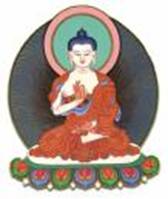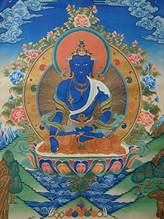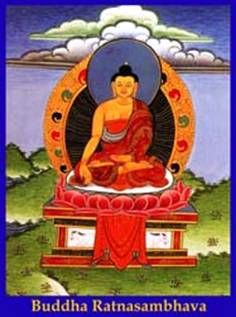
Suzan Doan
Acton Boxborough Regional High School - Acton, Massachusetts.
Tibetan Buddhism and Sakya Masters
| Who is Buddha? Buddhas are those who have accomplished the ten bhumis (stages of attainment), attained perfect enlightenment, are freed from the cyclic existence within the six realms of samsara ( Gods, Demi Gods, Human, Animal, Hungry Ghost, and Hell). Among the Buddhas of the past, Buddha Sakyamuni is known as the fourth Buddha and the teacher of the Buddhist doctrine.
Photographed by S. Doan Buddha Sakyamuni (Sage of the Sakyas) was born in the kingdom of Kapilavastu , in modern Nepal around 2500 years ago. He was named Sidharta Gautama, son of King Suddhodana and Queen Maya. The Wiseman predicted that the prince would either become the spiritual leader or a great ruler. Wishing for the later, King Suddhodana presented the prince with all the luxuries and shielded Sidharta from worldly unpleasant sights. The prince was married to beautiful princess, Yasodhara. One day, on a tour outside of the palace, the prince encountered the four sights of : sickness, old age, death, and a wondering monk. When returned to the palace the prince renounced his privilege life to become an ascetic in search for the solution to end suffering of mankind at the age of twenty nine, after the birth of his only son Rahula. For six years, the prince practiced rigorous asceticism, but he did not attain full enlightenment. He abandoned this traditional practice and adopted a middle path. One evening, under the Bodhi tree on the bank of the river Neranjara at Bodhgaya, he attained perfect wisdom. His son, Rahula and wife, Yashodhara subsequently were ordained by the Buddha, and also achieved enlightenment.
SYMBOLISM OF THE FIVE DHYANI (CELESCIAL) BUDDHAS
Photographed by S. Doan In Tantric Buddhist teaching, the five Dhyani Buddhas are the five wisdoms that transform the five aggregates of form, feeling, ideation, formation and consciousness. These five Buddhas help to bring spiritual transformation to practitioners through the practice of tantra. Within the mandala, each of these five Cosmic Buddhas resides in a particular Buddha realm, and is depicted with specific color.
AMOGHASIDDHI - North
Photo from web Buddha Amoghasiddhi is green in color, and is known as the Buddha of fearlessness. In the mandala, he resides in the northern direction. He represents the wisdom of accomplishment, or unobstructed success. Amoghasiddhi purifies the defilement of jealousy. The symbol associating with Amoghasidhi is the thunderbolt, or diamond scepter; he is with the element of air, locating at the base chakra. The palm facing out mudra in his right hand suggests fearlessness and protection, his left hand is in the meditative gesture. VAIROCHANA Central Photo from web Buddha Vairochana is white in color, known as the great illuminator, the sun. He usually resides at the center of the mandala, empowering the mirror-like transcendental wisdom or the ultimate truth. Vairochana is of water element, associating with the crown chakra, purifying ignorance. His hand's mudra is known as the turning of the wheel or teaching mudra.
AKSHOBHYA East
Photo from web Buddha Akshobhya resides in the Eastern paradise of Abhirati. Akshobhya is blue, the color of ultimate truth. This is the wisdom of Dharmadhatu. Buddha Akshobhya is the Buddha of loving kindness and patience, he purifies the defilement of anger in sentient beings and awakens beings to see the true nature of reality. This Buddha is of the water element being located at the heart chakra, the center of consciousness.
RATNASAMBHAVA South Photo from web Buddha Ratnasambhava is in yellow color . He represents a wish-fulfilling gem, with supreme giving and generosity. Buddha Ratnasambhava is the trancendental wisdom of equanimity and is associated with the earth element. He helps practitioners to transform pride, greed into an endless fountain of wealth. The associating chakra is at the navel. Ratnasambhava's hand gesture signifies endless generosity.
AMITABHA West
Photo from web Buddha Amitabha resides in Western Pure Land or Sukhavati. He is known as the Buddha of Infinite Light and compassion who aids beings by transforming their desires and attachment into the wisdom of discernment. The red color signifies the fire element that burns delusion. Amitabha empowers the knowledge of discernment. In Tibetan Buddhism, practitioners visualize Amitabha at the throat chakra. Buddha Amitabha is in meditative mudra.
Copyright © 2006 Suzan Doan All Rights Reserved |
This site was created by Suzan Doan at the NEH Summer Institute "Cultures and Religions of the Himalayan Region," held at the College of the Holy Cross, Summer 2006








